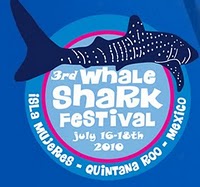A photo post from field work in Mexico
 Wednesday, August 25, 2010 at 12:12PM
Wednesday, August 25, 2010 at 12:12PM Sorry things have been a bit quiet on the blog lately. Our field work season has reached a crescendo, with several back-to-back trips to Mexico where I and others from Georgia Aquarium are studying whale sharks that aggregate annually in the coastal waters of the Yucatan, and thats left little time for writing. To learn more about the whale shark project, go here. Its been a real treat lately, with hundreds of sharks feeding in the area east of Isla Contoy and Isla Mujeres. Between the boat work, which focuses on photo cataloguing and ecological sampling, and aerial surveys, which focus on counting and distribution, we’ve been gathering a ton of data that will help shed light on why these aggregations form, and how to better protect them in the future. Rather than write about it, I figured I’d let the pictures do some talking. Required legalese: all these images are copyright 2010 Alistair Dove/Georgia Aquarium and may not be reproduced without permission.
 Flating mats of Sargassum are home to all sorts of things. These baby jacks were seeking shelter from me and caught a red reflection off my rashguard
Flating mats of Sargassum are home to all sorts of things. These baby jacks were seeking shelter from me and caught a red reflection off my rashguard This is what we came for: a whale shark feeding east of the Yucatan.
This is what we came for: a whale shark feeding east of the Yucatan. Any port in a storm: this tiny 2 inch barracuda was hitching a ride with a moon jelly
Any port in a storm: this tiny 2 inch barracuda was hitching a ride with a moon jelly
 Most filefish live on rocky and coral reefs, but this one was vigorously defending a little bit of Sargassum
Most filefish live on rocky and coral reefs, but this one was vigorously defending a little bit of Sargassum Its hard not to feel like the whale sharks are checking you out sometimes
Its hard not to feel like the whale sharks are checking you out sometimes
 Georgia Aquarium senior aquarist Marj Awai wielding the 7D and housing: stills AND HD video *drool*
Georgia Aquarium senior aquarist Marj Awai wielding the 7D and housing: stills AND HD video *drool* People are the biggest threat to whale sharks. This male had a close encounter with a boat but luckily came away with only shallow scrapes. We see deeper cuts from propellers sometimes, and utmost caution is warranted when moving among the animals.
People are the biggest threat to whale sharks. This male had a close encounter with a boat but luckily came away with only shallow scrapes. We see deeper cuts from propellers sometimes, and utmost caution is warranted when moving among the animals. The most common view of a whale shark. Even though they seem to swim effortlessly, keeping up with them is only possible for short distances. This is the last one we’ll see until next years field work season. Adios amigo!
The most common view of a whale shark. Even though they seem to swim effortlessly, keeping up with them is only possible for short distances. This is the last one we’ll see until next years field work season. Adios amigo!
 1 Comment |
1 Comment |  Email Article | tagged
Email Article | tagged  Georgia Aquarium,
Georgia Aquarium,  SCUBA,
SCUBA,  Yucatan,
Yucatan,  fish,
fish,  mexico,
mexico,  photography,
photography,  research,
research,  whale sharks
whale sharks 









